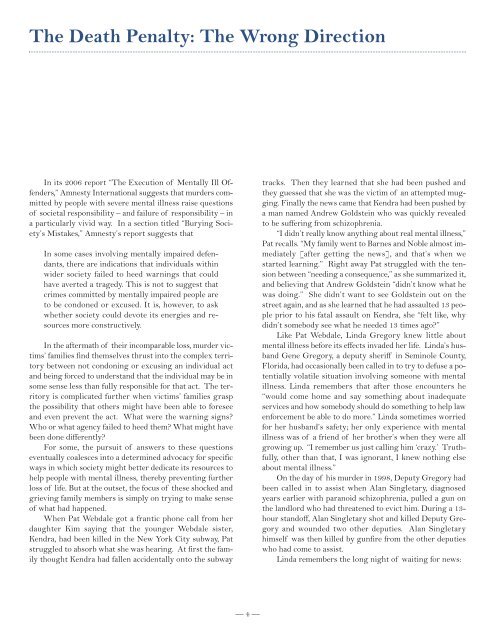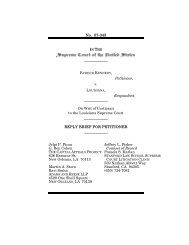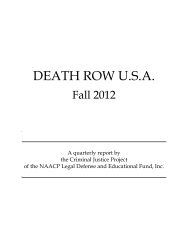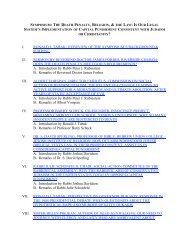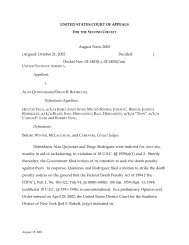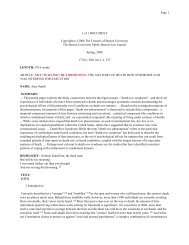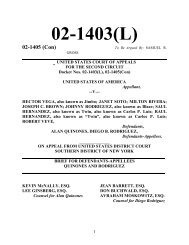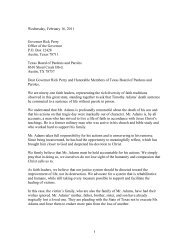sense of common cause. What the families gathered aroundthe table overwhelmingly found was a shared understandingand shared longing to address, at the root, the problemthat had brought them all together.This report 7 now gives public voice to this shared commitmentby asserting that the death penalty is not only inappropriateand unwarranted <strong>for</strong> persons with severe mentalillness but that it also serves as a distraction from problemswithin the mental health system that contributed or even leddirectly to tragic violence. <strong>Families</strong> of murder victims andfamilies of people with mental illness who have committedmurder have a cascade of questions and needs. It is to thesequestions, rather than to the death penalty, that as a societywe must turn our attention and our collective energies if weare truly to address the problem of untreated mental illnessand the lethal violence that can result.To legislative and public education campaigns, this reportadds voices from a distinct constituency that is otherwisemissing from advocacy ef<strong>for</strong>ts on the issue. Withoutthis testimony, advocacy in favor of exempting offenderswith severe mental illness from the death penalty is open tothe charge of being unconcerned with victims. Specifically,policymakers may fear that a vote in favor of exempting offenderswith severe mental illness from the death penaltywill be viewed as a vote against the interests of victims. Testimonyfrom families of victims directly refutes this charge.Victims’ opposition to the death penalty <strong>for</strong> offenderswith certain severe mental illnesses is rooted in their ownexperience of traumatic loss and in their ef<strong>for</strong>t to understandhow their loved one came to be murdered. For this reason,a victim-oriented discussion of exempting offenderswith severe mental illness from the death penalty is inextricablytied to a discussion of the circumstances surroundingthe murder and the need <strong>for</strong> greater mental health interventionin order to reduce the likelihood of violence. A victim-orientedexamination of the issue of the death penaltyand mental illness cannot look only at the specific questionof whether offenders with severe mental illness should beexempt from the death penalty but must also give seriousconsideration to victims’ questions about intervention, prevention,and how the notion of diminished culpability relatesto accountability and to victims’ right to in<strong>for</strong>mationand participation in the proceedings. Thus, the discussionthat follows will encompass these considerations, as will therecommendations <strong>for</strong> policy re<strong>for</strong>m that are presented at theend of the report.7See Appendix B <strong>for</strong> a description of methodology, including how the intervieweeswere found. The report is based on interviews with (and supplementalmaterial from) 21 family members who meet the above criteria. Other similarstories from family members whom we were not able to interview directly havealso in<strong>for</strong>med our thinking on the issue.On October 3, 2008, in San Antonio, Texas, a privategathering followed by a public ceremony markedthe official launch of the NAMI/MVFHR “Prevention,Not Execution” Project. Victims’ families and familiesof the executed, all of whom had been affected bymental illness, murder, and the death penalty, traveledfrom Florida, Georgia, Tennessee, North Carolina,Cali<strong>for</strong>nia, Maine, Massachusetts, and elsewhere inTexas to participate. During the two-and-a-half hourmorning gathering, participants sat around a table andshared their stories. The event later that afternoon, attendedby supporters and members of the press, featuredbrief public statements and then a ceremony inwhich participants placed roses in a vase in memory ofthe losses represented at the gathering.In addition to making a public statement againstthe death penalty <strong>for</strong> people with mental illness whohave committed murder, the gathering had a profoundeffect on those who participated. People who had notpreviously met one another found themselves sharingtheir most painful memories; Julie Nelson referred to itlater as an experience of being among people who hadbeen “broken open” - made open to personal revelationby what they had undergone. As well, the gatheringyielded some unexpected feelings of affinity betweenfamilies of victims and families of the executed.Joe Bruce reflected on the experience with thesewords: “The San Antonio experience was one of themost extraordinary things that I have ever had theprivilege of being a part of. To see the effect that executionshad on the [family members of the executed]who had committed no crime whatsoever, who had alreadystruggled <strong>for</strong> years to get help <strong>for</strong> [their familymember] – I saw that and said that [the deathpenalty] is just absolutely a practice that should beended.”Bonnie Stawski, whose brother Robert Coe hadbeen executed in Tennessee eight years prior to thegathering, said, “I cannot describe the peace I felt sittingaround that table in San Antonio. Everybody’spain was different, everybody’s situation was different,but I felt a bond with everyone that was like good medicine.”__ 3 __
The Death Penalty: The Wrong DirectionIn its 2006 report “The Execution of Mentally Ill Offenders,”Amnesty International suggests that murders committedby people with severe mental illness raise questionsof societal responsibility – and failure of responsibility – ina particularly vivid way. In a section titled “Burying Society’sMistakes,” Amnesty’s report suggests thatIn some cases involving mentally impaired defendants,there are indications that individuals withinwider society failed to heed warnings that couldhave averted a tragedy. This is not to suggest thatcrimes committed by mentally impaired people areto be condoned or excused. It is, however, to askwhether society could devote its energies and resourcesmore constructively.In the aftermath of their incomparable loss, murder victims’families find themselves thrust into the complex territorybetween not condoning or excusing an individual actand being <strong>for</strong>ced to understand that the individual may be insome sense less than fully responsible <strong>for</strong> that act. The territoryis complicated further when victims’ families graspthe possibility that others might have been able to <strong>for</strong>eseeand even prevent the act. What were the warning signs?Who or what agency failed to heed them? What might havebeen done differently?For some, the pursuit of answers to these questionseventually coalesces into a determined advocacy <strong>for</strong> specificways in which society might better dedicate its resources tohelp people with mental illness, thereby preventing furtherloss of life. But at the outset, the focus of these shocked andgrieving family members is simply on trying to make senseof what had happened.When Pat Webdale got a frantic phone call from herdaughter Kim saying that the younger Webdale sister,Kendra, had been killed in the New York City subway, Patstruggled to absorb what she was hearing. At first the familythought Kendra had fallen accidentally onto the subwaytracks. Then they learned that she had been pushed andthey guessed that she was the victim of an attempted mugging.Finally the news came that Kendra had been pushed bya man named Andrew Goldstein who was quickly revealedto be suffering from schizophrenia.“I didn’t really know anything about real mental illness,”Pat recalls. “My family went to Barnes and Noble almost immediately[after getting the news], and that’s when westarted learning.” Right away Pat struggled with the tensionbetween “needing a consequence,” as she summarized it,and believing that Andrew Goldstein “didn’t know what hewas doing.” She didn’t want to see Goldstein out on thestreet again, and as she learned that he had assaulted 13 peopleprior to his fatal assault on Kendra, she “felt like, whydidn’t somebody see what he needed 13 times ago?”Like Pat Webdale, Linda Gregory knew little aboutmental illness be<strong>for</strong>e its effects invaded her life. Linda’s husbandGene Gregory, a deputy sheriff in Seminole County,Florida, had occasionally been called in to try to defuse a potentiallyvolatile situation involving someone with mentalillness. Linda remembers that after those encounters he“would come home and say something about inadequateservices and how somebody should do something to help lawen<strong>for</strong>cement be able to do more.” Linda sometimes worried<strong>for</strong> her husband’s safety; her only experience with mentalillness was of a friend of her brother’s when they were allgrowing up. “I remember us just calling him ‘crazy.’ Truthfully,other than that, I was ignorant, I knew nothing elseabout mental illness.”On the day of his murder in 1998, Deputy Gregory hadbeen called in to assist when Alan Singletary, diagnosedyears earlier with paranoid schizophrenia, pulled a gun onthe landlord who had threatened to evict him. During a 13-hour standoff, Alan Singletary shot and killed Deputy Gregoryand wounded two other deputies. Alan Singletaryhimself was then killed by gunfire from the other deputieswho had come to assist.Linda remembers the long night of waiting <strong>for</strong> news:__ 4 __


